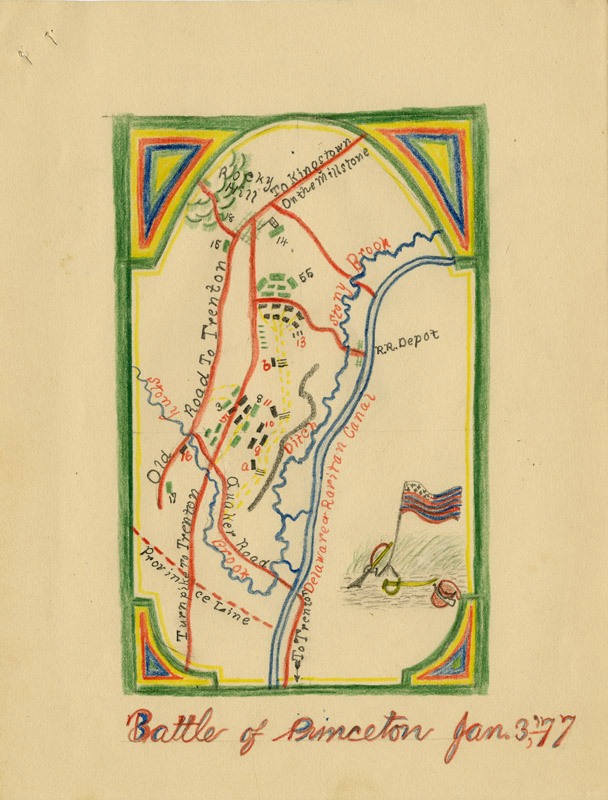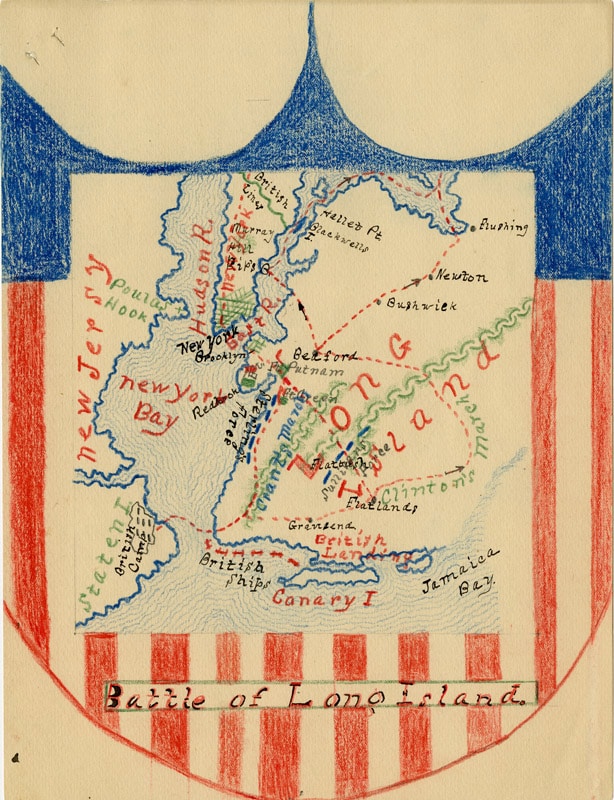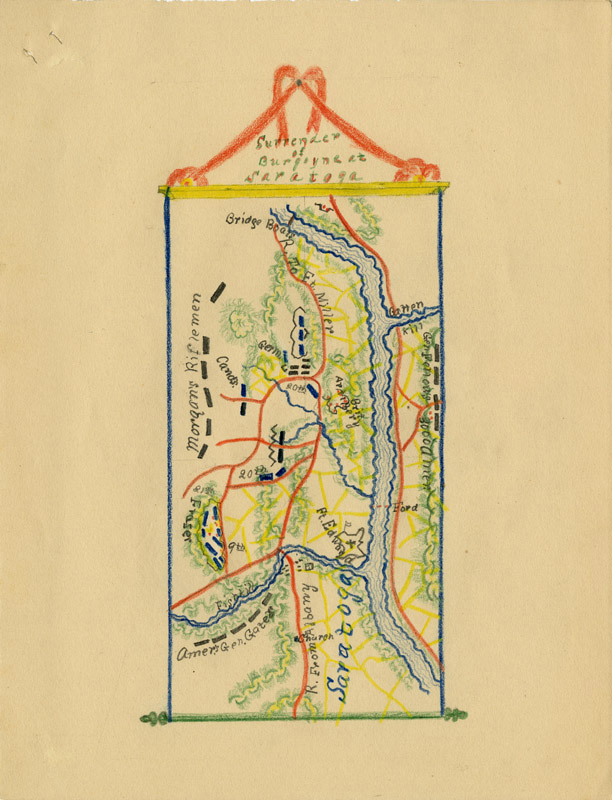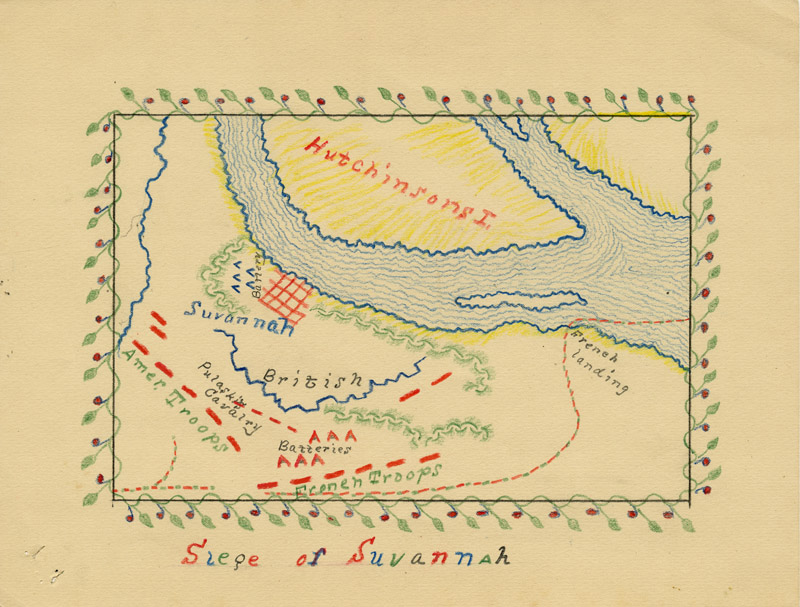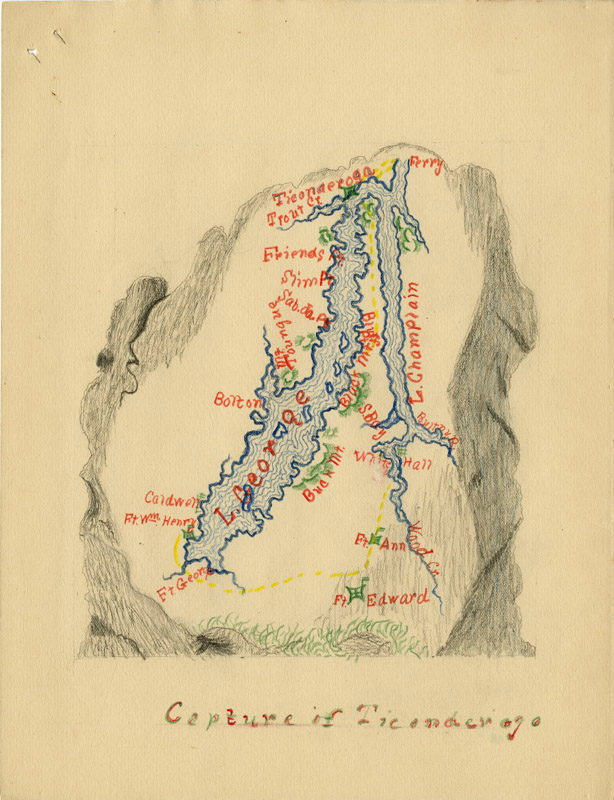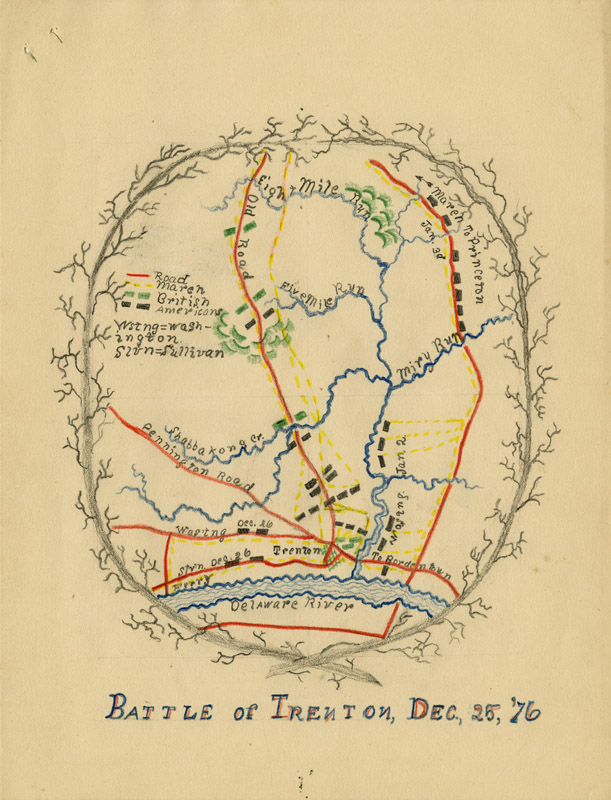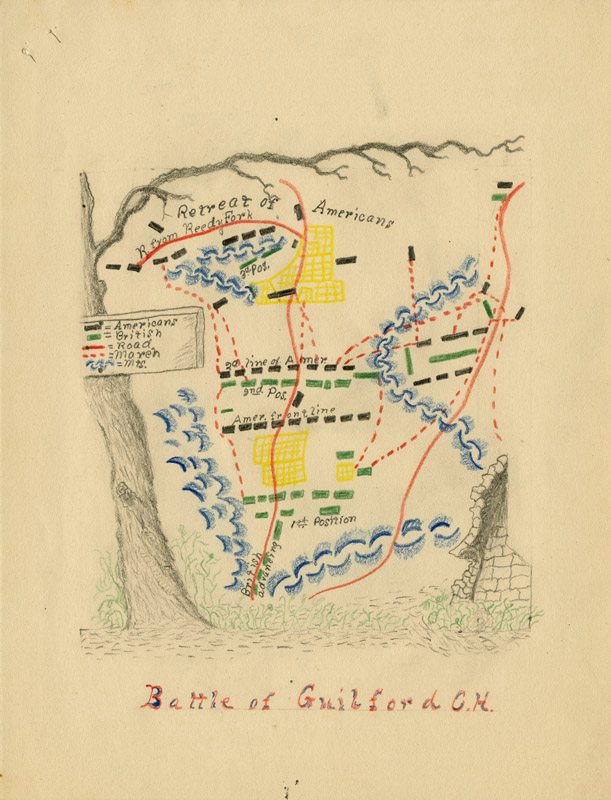School Work
Student work from the Carlisle Indian Industrial School
Below are some examples of academic work done by students while at the Carlisle Indian School in the collections of the Cumberland County Historical Society.
The first set of work is from Charles Dagenett, CIS class of 1891.
- Title Page of Charles Dagnett’s Drawings presented to Susan Longstreth
- Battle of Princeton, 1777
- Battle of Long Island
- Surrender of Burgoyne at Saratoga
- Siege of Suvannah
- Capture of Ticonderoga
- Battle of Trenton, 1776
- Siege of Yorktown
- Siege of Charleston, 1780
- The Father of his Country [George Washington]
- Battle of Guilford, O.H.
Work from The Sewing Room, Grade 1 Room 1 under Teacher Miss Hetrick for the 1907-1908 school year.
David Shebear – Cheyenne Nation, First Grade, Age 20
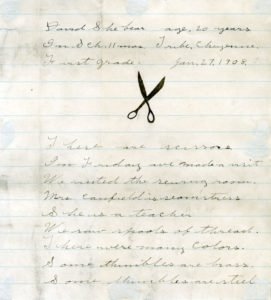
David Shebear (PI_4-5-1)
David Shebear age, 20 years
In Sch. 11 mos. Tribe, Cheyenne.
First grade. Jan. 27, 1908
These are scissors.
On Friday we made a visit
We visited the sewing room.
Mrs. Canfield is seamstress
She is a teacher
We saw spools of thread.
There were many Colors.
Some thimbles are brass.
Some thimbles are steel
Wallace Touhojuma – Hopi Nation, First Grade, Age 20
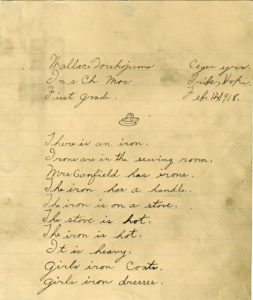
Wallace Touhojuma (PI_4-5-2)
Wallace Touhojuma Ceger(?) yrs.
In sCh Mos Tribe, Hopi.
First grade. Feb. 13, 1908.
There is an iron.
Irons are in the sewing room.
Mrs Canfield has irons.
The iron has a handle.
The iron is on a stove.
The stove is hot.
The iron is hot.
It is heavy.
Girls iron Coats.
Girls iron dresses.
Archie Quamalitchtewa – Hopi Nation, First Grade, Age 20
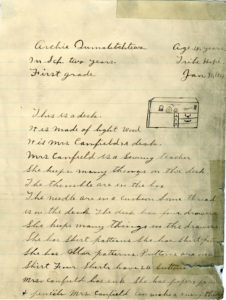
Archie Quamalitchtewa Pg. 1 (PI_4-5-3)
Archie Qumalitchtwea Age. 18, years
In Sch. two years. Tribe Hopi.
First grade. Jan. 31, 1908
This is a desk.
It is made of light wood
It is Mrs Canfield,s desk.
Mrs Canfield is a sewing teacher
She keeps many things on the desk.
The thimble are in the box
The needle are in a cushion. Some thread is on the desk. The desk has four drawers.
She keeps many things in the drawers.
She has skirt patterns. She has shirt patterns.
She has collar patterns. Buttons are on a Shirt. Four Shifts have 24 buttons
Mrs. Canfield has ink She has papers pens and pencils Mrs. Canfield can make a every thing.

Archie Quamalitchtewa Pg. 2 (PI_4-5-3)
She can make a dress and apron
Mrs Canfield
Andrew Hermequatewa – Hopi Nation, First Grade, Age 16
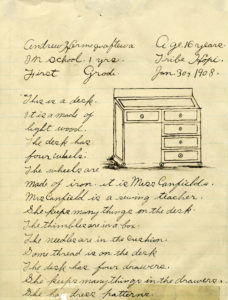
Andrew Hermequatewa Pg. 1
(PI_4-5-4)
Andrew Hermequatewa Age. 16 Years.
In school. 1 yrs. Tribe Hopi.
First Grade Jan. 30, 1908.
This is a desk.
It is a made of light wood.
The desk has four wheels.
The wheels are made of iron. it is Miss Canfields.
Mrs Canfield is a sewing teacher.
She keeps many things on the desk.
The thimbles are in a box.
The needles are in the cushion.
Some thread is on the desk
The desk has four drawers.
She keeps many things in the drawers.
She has dress patterns.
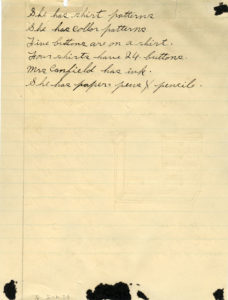
Andrew Hermequatewa Pg. 2
(PI_4-5-4)
She has shirt patterns
She has collar patterns
Five buttons are on a shirt.
Four shirts have 24. buttons.
Mrs Canfield has ink.
She has paper, pens X pencils.
Nora McFarland – Nez Perce Nation, First Grade, Age 18
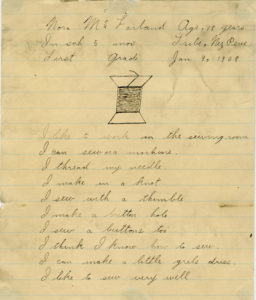
Nora McFarland (PI_4-5-5)
Nora McFarland Age, 18 years
In sch 5 mos Tribe, Nez Perce
First Grade Jan 9, 1908
I like to work in the sewing room
I can sew on a machine.
I thread my needle
I make in a knot
I sew with a thimble
I make a button hole
I sew a buttons too
I think I know how to sew
I can make a little grils [sic] dress.
I like to sew very well
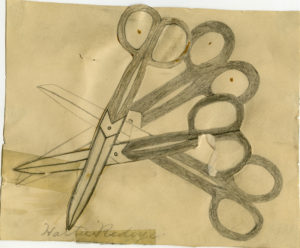
Hattie Redeye (PI_4-5-6)
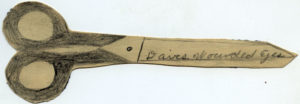
Davis Wounded Eyes (PI_4-5-7)
Glenn Josytewa – Hopi Nation, First Grade, Age 20
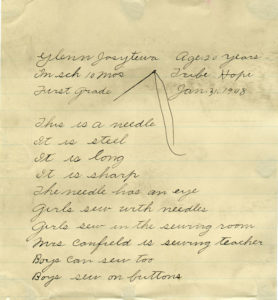
Glenn Josytewa Pg. 1 (PI_4-5-8)
Glenn Josytewa Age. 20 years
In sch 10 Mos Tribe Hopi
First grade Jan. 31, 1908
This is a needle
It is steel
It is long
It is sharp
The needle has an eye
Girls sew with needles
Girls sew in the sewing room
Mrs Canfield is sewing teacher
Boys can sew too
Boys sew on buttons

Glenn Josytewa Pg. 2 (PI_4-5-8)
Glenn Josytewa
It
Willis Medicine Bull – Cheyenne Nation, First Grade, Age 20

Willis Medicine Bull (PI_4-5-9)Willis Medicine Bull Age, 20 years.
In sch. 1 year. Tribe, Cheyenne
First grade Jan 27, 1908
This is a pin
Pins have heads.
The heads are round
Pins are steel
Girls need many pins
Pins come on papers
There are 40 pins in a row
There are 10 rows.
400 pins cost 5 Cents.
Hattie Bedeye (Hattie Redeye?)- Seneca Nation, First Grade, Age 20
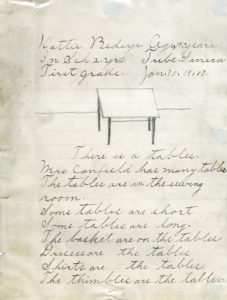
Hattie Bedeye (PI_4-5-10)
Hattie Bedeye Age, 19 years.
In Sch 2. yrs Tribe, Seneca
Tirst grade. Jan. 30, 19,08.
There is a tables.
Mrs Canfield has many tables.
The tables are in the sewing room.
Some tables are short
Some tables are long.
The basket are on the tables.
Dresses are the tables
Shirts are the tables
The thimbles are the tables.
Evarice Paul – Chittamache Nation, First Grade, Age 11

Evarice Paul (PI_4-2-1)
Evarice Paul First Grade
Age 11 years Tribe Chittamache
Spelling
1. clothes
2. soap
3. wash
4. rinse
5. tubs
6. irons
7. starch
8. boards
9. bluing
10. soda
11. driers
12. water
13. stove
14. steam
15. tables
16. smooth
17. sprinkle
18. pins
19. lines
20. baskets
Mitchell Tarbell – Seneca Nation, Second Grade, Age 11
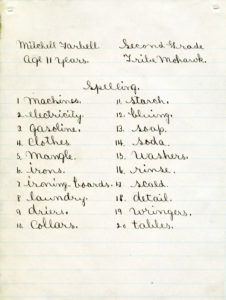
Mitchell Tarbell (PI_4-2-2)
Mitchell Tarbell Second Grade
Age 11 years. Tribe Mohawk
Spelling
1. machines.
2. electricity.
3. gasoline.
4. clothes.
5. mangle.
6. irons.
7. ironing boards.
8. laundry.
9. driers.
10. collars.
11. starch.
12. bluing.
13. soap.
14. soda.
15. washers.
16. rinse.
17. scald.
18. detail.
19. wringers.
20. tables.
Edna Bissonette – Sioux Nation, Second Grade, Age 9
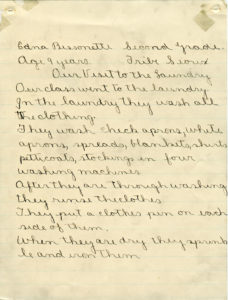
Edna Bissonette (PI_4-2-3)
Edna Bissonette Second Grade
Age 9 years Tribe Sioux
Our Visit to the Laundry
Our class went to the laundry.
In the laundry they wash all the clothing.
They wash check aprons, white aprons, spreads, blankets, shirts, petticoats, stockings in four washing machines.
After they are through washing they rinse the clothes
They put a clothes pin on each side of them.
When they are dry they sprinkle and iron them
Annie Loren – Mohawk Nation, Third Grade, Age 11
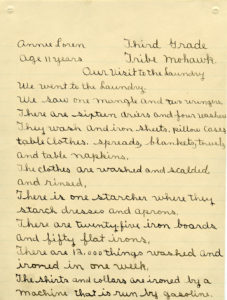
Annie Loren (PI_4-2-4)
Annie Loren Third Grade
Age 11 years Tribe Mohawk
Our Visit to the Laundry
We went to the Laundry.
We saw one mangle and two wringers.
There are sixteen driers and four washers
They wash and iron sheets, pillow cases, table clothes. spreads, blankets, towels, and table napkins.
The clothes are washed and scalded and rinsed.
There is one starcher where they starch dresses and aprons.
There are twenty-five iron boards and fifty flat irons.
There are 12,000 things washed and ironed in one week.
The shirts and collars are ironed by a machine that is run by gasoline.
Peter Mora – Chittamache Nation, First Grade, Age 11
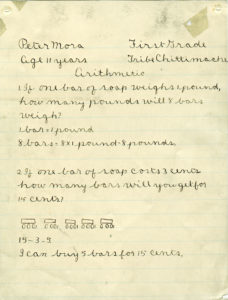
Peter Mora (PI_4-2-5)
Peter Mora First Grade
Age 11 years Tribe Chittimache
Arithmetic
If one bar of soap weighs 1 pound, how many pounds will 8 bars weigh?
1 bar = 1 pound
8 bars = 8 x 1 pound – 8 pounds.
If one bar of soap costs 3 cents how many bars will you get for 15 cents?
15 – 3 – 5
I can buy 5 bars for 15 cents.
Anna King – Oneida Nation, Third Grade, Age 10
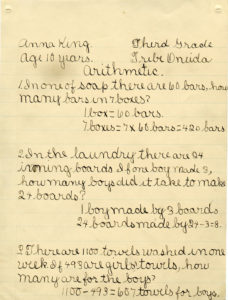
Anna King (PI_4-2-6)
Anna King Third Grade
Age 10 years Tribe Oneida
Arithmetic.
In one of soap there are 60 bars, how many bars in 7 boxes?
1 box = 60 bars
7 boxes = 7 x 60 bars = 420 bars
In the laundry there are 24 ironing boards If one boy made 3, how many boys did it take to make 24 boards?
1 boy made by 3 boards
24 boards made by 24 – 3 = 8
There are 1100 towels washed in one week. If 493 are girls’ towels, how many are for the boys?
1100-493 = 607 towels for boys.
Thomas Smith – Mohawk Nation, Age 11
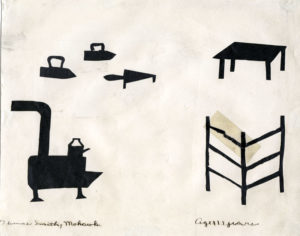
Thomas Smith (PI_4-2-7)
George Grinnell – Gros Ventre Nation, Sixth Grade, 1908
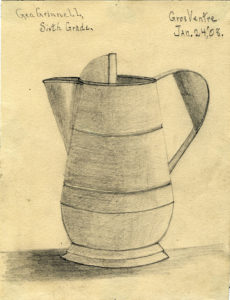
George Grinnell (PI_4-7-1)
Henry Chapman – Pawnee Nation, Sixth Grade, January 24, 1908
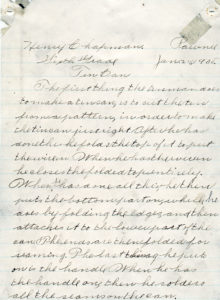
Henry Chapman (PI_4-7-2)
Henry Chapman. Pawnee
Sixth Grade Jan. 24, 1908.
Tin Can
The first thing the tinman does to make a tin can, is to cut the tin from a patter, in order to make the tin can just right. After he has done this he folds the top of it to put the wire in. When he has the wire in he closes the folded top entirely. When he has done all this, he then puts the bottom part on, which he does by folding the edges, and then attaches it to the lower part of the can. The ends are then folded for seaming. The last thing he puts on is the handle. When he has the handle on, then he solders all the seams on the can.
Esiah Galashoff – Alaskan Nation, Sixth Grade, January 24, 1908

Esiah Gallashoff (PI_4-7-3)
Esiah Gallashoff. Alaskan.
Sixth Grade. Jan. 24, 1908
A Tin cup.
First, the tin is cut and then comes the beading, and after the beading the ends are folded for seaming.
Next they fold the top and put in the wire, after which they cloze it and make both ends meet.
After it is closed, they put in the bottom and after that they put on the handle.
After the handle is put on the cup is done but soldering the seams.
A quart measure is made in the same style but some-
Jennie Blackshield – Sioux Nation, Sixth Grade, January 15 1908
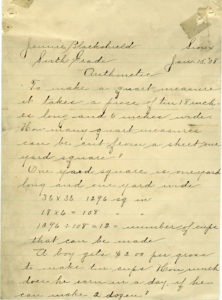
Jennie Blackshield Pg. 1 (PI_4-7-4)
Jennie Blackshield Sioux
Sixth Grade Jan. 15, ‘08
Arithmetic
To make a quart measure it takes a piece of tin 18 inches long and 6 inches wide. How many quart measures can be cut from a sheet one yard square?
One yard square is one yard long and one yard wide
36 x 36 1296 sq in
18 x 6 = 108 “ “
1296 ÷ 108 = 21 = number of cups that can be made
A boy gets $2 00 per gross to make tin-cups. How much does he earn in a day, if he can make 2 dozen?
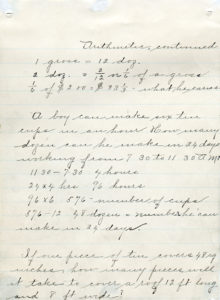
Jennie Blackshield Pg. 2 (PI_4-7-4)
Arithmetic, continued
1 gross = 12 doz.
2 doz. = 2/12 or 1/6 of a gross
1/6 of $2 00 = $33 1/3 – what he earns
A boy can make six tin cups in an hour. How many dozen can he make in 24 days working from 7 30 to 11 30 AM?
11 30 – 7 30 4 hours
24 x 4 hrs 96 hours
96 x 6 576 – number of cups
576 ÷ 12 48 dozen = number he can make in 24 days.
If one piece of tin covers 48 sq inches, how many pieces will it take to cover a roof 12 ft long and 8 ft wide?
Dewitt Wheeler – Sixth Grade
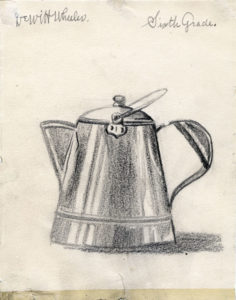
Dewitt Wheeler (PI_4-7-5)
Leila Schenandore – Oneida Nation, Sixth Grade, January 27, 1908
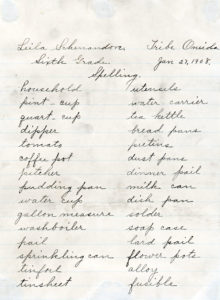
Leila Schenandore (PI_4-7-6)
Leila Schenandore Tribe Oneida
Sixth Grade. Jan 27, 1908.
Spelling
household utensils
pint-cup water carrier
quart-cup tea kettle
dipper bread pans
tomato pietins
coffee pot dust pans
pitcher dinner pail
pudding pan milk can
water cup dish pan
gallon measure solder
washboiler soap case
pail lard pail
sprinkling can flower pots
tinfoil alloy
tinsheet fusible
Clarence De Graff – Pottawatomi Nation, Sixth Grade, January 24, 1908
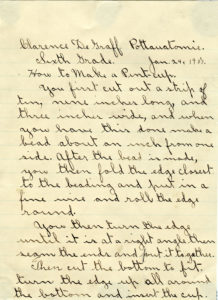
Clarence De Graff (PI_4-7-7)
Clarence DeGraff. Pottawatomie.
Sixth Grade. Jan. 24, 1908
How to Make a Pint-cup.
You first cut out a strip of tin, nine inches long, and three inches wide, and when you have this done make a bead about an inch from one side. After the bead is made, you then fold the edge closest to the beading and put in a fine wire and roll the edge round.
You then turn the edge until it is at a right angle then seam the ends and put it together.
Then cut the bottom to fit, turn the edge up all around the bottom and insert the cup.

